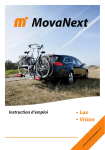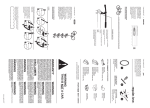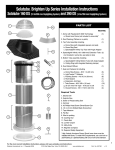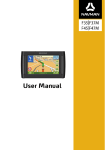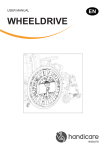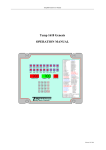Download 1 Your MovaNext
Transcript
MovaNext User manual for the Lux Vision MovaNexwww.movanext.com t Introduction Congratulations on the purchase of your MovaNext bike carrier! This manual contains important user information with tips and warnings about correct and safe use of the product. So read this manual carefully before using the product. Your bike carrier is ready for use and set for a standard tow bar with a throat thickness of 28 mm and a tow ball with a diameter of 50 mm. We wish you lots of pleasure while using the MovaNext! The MovaNext bicycle carrier has EU type approval granted by the RDW. Symbols in this manual Note: These are points you must bear in mind while using the bicycle carrier. You then avoid damage and unsafe situations. Tip: Information to use the MovaNext safer and easier. 2 MovaNext MovaNex t 3 Contents 1 2 3 4 5 6 7 8 9 10 11 12 13 1 Your MovaNext Components Points for attention Tips Fitting the bicycle carrier Mounting the bicycle(s) Using the ramp Dismounting the bicycle(s) Removing the bicycle carrier Bicycle transport and the law Maintenance and replacement Fitting on a tow bar Guarantee conditions 5 6 7 10 11 13 16 17 19 21 22 23 30 Your MovaNext This manual explains the use of two versions of the MovaNext bicycle carrier - the Lux and the Vision. Lux Lighting: filament bulbs No tilting mechanism Vision Lighting: LED No tilting mechanism Both versions are the same except for the lights. In the rest of the manual only the Lux is pictured to explain use. 4 MovaNext MovaNex t 5 2 Components 3 This section explains the parts of the MovaNext. The pictures show the Lux. More information and instruction films can be found at www.movanext.com 1. Use the parts list in section 2 to check that all necessary parts of the carrier have been supplied. Check that all parts are intact and in working order. 2. If a part is missing or not in working order it must be replaced to ensure the safety of your bicycle carrier. In such a case contact your supplier. For information about ordering parts see www.movanext.com 3. The bicycle carrier may only be used to transport a maximum of two bicycles. 4. The bicycle carrier can carry a maximum load of 60 kg. The weight of the Lux and Vision is 12.5 kg. Make sure that the maximum trailer nose weight of the tow bar is not exceeded. MovaNext Lux 1. Lock knob arm with frame clamps 7. Central tube 2. Frame clamp with lock knob 8. Height adjustment knob 4. 7/13-pole plug socket 9. Frame clamp with lock knob 3. Wheel ramp (4x) 10. Lock for locking 5. Left-hand blade 11. Automatic locking 12. Sliding wheel clamp with wheel strap (4x)) 13. Right-hand blade 6. Number plate holder Points for consideration The table mentions the maximum permitted weight for one or two bicycles on the bicycle carrier in combination with a specific permitted trailer nose weight. The difference between the permitted trailer nose weight and the maximum weight on the bicycle carrier is 12.5 kg, being the weight of the carrier itself. MovaNext Lux/ Vision 6 MovaNext Permitted trailer nose weight Carrier weight Maximum weight 2 bicycles Maximum weight 1 bicycle 50 kg 12.5 kg 37.5 kg 30 kg 60 kg 12.5 kg 47.5 kg 30 kg 70 kg 12.5 kg 57.5 kg 30 kg 75 kg 12.5 kg 60 kg 30 kg 80 kg or more 12.5 kg 60 kg 30 kg MovaNex t 7 original replacement parts and the use of bungee cords is also not allowed. The bicycle carrier is unsuitable for driving on unsurfaced roads and driving at speeds higher than 130 kph. 5. Always fit the wheel clamps on the wheels of a bicycle using the wheel straps. These wheel straps fix the bicycle to the carrier and the wheels cannot move out of the wheel rail while driving. 6. On longer journeys or if driving over poor or unhardened surfaces regularly (every 2-3 hours) check the fastening of the bicycles and carrier. 15. The bicycle carrier is only suitable for standard two-wheeled bicycles. Tandems or three-wheelers may not be transported on the bicycle carrier. 7. Before you drive off always check that the bicycle carrier lights are working. Driving with a bicycle carrier with the lights not working is an offence. The driver of the car is responsible for this. 16. Take care when mounting a bicycle with a carbon frame. Fixing too firmly can cause damage to these bicycles. The manufacturer accepts no liability for damage to carbon frames. 8. Child’s seats, water bottles, etc. must be removed from the bicycle. These items can come loose while driving. It is recommended to also remove bicycle bags from the bicycle. 9. If the carrier is not mounted on the tow bar, always place the tow bar plug in its holder. This is to prevent damage. 10. The bicycle carrier can be locked to prevent theft and inadvertent unlocking. So always use these locks when you are on the way with the MovaNext. 11. When fitting and removing the bicycle carrier make sure that you first unlock the lock. You then avoid damage to the carrier. 12. To extend the life of the bicycle carrier it is important to store the carrier in a dry place and maintain it properly (see section 11: Maintenance and replacement). 13. If you have had an accident with your vehicle while the bicycle carrier was assembled, you must have the carrier checked for damage by the dealer. You must also check the carrier after swerving or after driving on a poor surface for any length of time. 14. No changes of any nature may be made to the carrier. Using non- 8 MovaNext MovaNex t 9 4 Tips 5 Fitting the bicycle carrier 1. Preferably fit the frame clamps as high as possible on the saddle or frame tube of the bicycle for maximum stability. 1. Assembling the bicycle carrier on the tow bar 2. When storing, place the bicycle carrier upright with the grip facing upwards. You then avoid damage to the carrier. 3. The total length of the vehicle increases when the bicycle carrier is assembled. The height and width can also increase. Remember this when reversing, parking, etc. Make sure that the tow ball is not dirty or greasy. Fit the bicycle carrier slightly tilted towards you on the tow bar then bring it upright. 4. Remove the bicycle carrier from the tow bar before you drive into a car wash. 2. Loosen the clip 5. To save fuel it is advisable to not assemble the bicycle carrier on the tow bar when no bicycles are being transported. 6. If your vehicle has a boot lid that automatically opens it is advised to switch this function off. You then avoid damage to the bicycle carrier and your vehicle. The two blades are kept together by a clip. Loosen the clip in order to fold the blades out. The two blades are kept together by a clip. Loosen the clip in order to fold the blades out. 7. Go to www.movanext.com for accessories and more information on how to use the bicycle carrier in a more simple way. 8. The 13-pole plug socket works with a bayonet catch so the plug turns a quarter turn and is firmly fixed. Should the plug not fit in the connection on your car check if: • the notch in the plug matches the recess in the socket on the car (see figure). • the 3 slots in the plug are correctly positioned for the notch in the socket (see figure). • the pins are correctly positioned for the notch (see figure). 10 MovaNext 3. Fold out the right-hand blade Fold the right-hand blade downwards to make it horizontal. Keep the central tube as vertical as possible. You can release the bicycle carrier; it is now clamped on the tow bar. 4. Connect the plug Take the plug from the holder and insert it in the car’s plug socket. The plug has a 7- and a 13-pole side. Cover the unused plug part with the cap supplied. MovaNex t 11 6 5. Fold out the left-hand blade 1. Wheel straps Fold the left-hand blade downwards until it is flat. Keep the central tube as vertical as possible. When both blades are fully folded out the bicycle carrier secures automatically. Insert the wheel straps in their holders in order to place them along the rails and do not impede the placing of the bicycle. 6. Automatic locking 2. Fold the frame clamps upwards When the blades are in the correct position, the blades lock automatically and you hear a click. Folding the frame clamps upwards makes placing the bicycle(s) easier. First loosen the locking button to do this. The slide next to the lock is then slid towards you. This can be particularly useful when using a ramp (see section 7). 7. Check the bicycle carrier 3. Place the bicycle in front of the bicycle carrier Check that the carrier stays straight by alternately pressing the blades. Check the clamping force by pulling a blade towards you. Place the first (lady‘s) bicycle in front of the carrier with the chain guard facing the car. Then squeeze both brakes and lift the front wheel into the rail. t. See section 12 if the carrier is not straight or if clamping is not sufficient. 8. Locking The lock is used to secure the carrier. You then make sure that the lock does not spring back. Turn the key and pull the key out of the lock. 12 Mounting bicycles MovaNext y 4. Place the bicycle in the wheel rail Lift the rear wheel into the wheel rail. One hand remains on the handlebars. You can also use a ramp to put the bicycle(s) on the MovaNext. MovaNex t 13 5. Lift into the back wheel rails 9. Move the wheel rails Lift the bicycle from the front wheel rails into the rear wheel rails. Slide both wheel clamps as close as possible to the wheels and fasten the wheel straps: insert the wheel straps through their openings and tighten them. Make sure that the bicycles are in the middle of the carrier. 6. Bring the frame clamps to height 10. Place a second bicycle Loosen the height adjustment knob. Adjust the arm to the correct height. Then tighten the knob again finger-tight. Repeat steps 1 to 9 for the second bicycle. 7. Fix the fame clamps 11. Check fastening points Loosen the frame clamp and preferably position it as high as possible on the saddle tube. Turn it finger-tight. Never turn the lock knob fully out of the screw thread. 8. Lock the frame clamps Door gebruik te maken van de sloten in de slotknoppen beschermt u de fietsen tegen diefstal. After locking remove the key from the lock. 14 MovaNext Always place a second bicycle in the opposite direction to the first bicycle. Check whether: • the height adjustment knob, lock knob and frame clamps are tightened finger-tight. • the wheel straps are pulled tight. • the keys have been removed from the lock knobs. 12. Check the position of the carrier The bicycle carrier must be fixed upright on the tow bar. You can check this by looking from the side to see if the central tube is vertical. MovaNex t 15 7 Using the ramp 1. Assembly The ramp consists of two parts. Connect the two parts to each other by inserting the pin of the one part in the hole in the other. 8 Dismounting the bicycle(s) 1. One bicycle at a time Only one bicycle at a time can be lifted from the carrier. Only loosen the belts and frame clamp of the bicycle you are going to remove. 2. Place the ramp against the carrier 2. Loosen the wheel straps Place the ramp alongside the carrier. The hook at the end of the ramp must fit in the wheel rail as shown in the figure. Loosen the wheel straps of the bicycle to be removed by pressing the blue knob and pulling the straps out. Fold the frame clamps upwards to ease the placing of the bicycle. 16 3. Ride the bicycle onto the carrier 3. Loosen the frame clamp Now ride the bicycle onto the carrier. Always keep at least one hand on the handlebars. Fold the frame clamps downwards when the bicycle is on the bicycle carrier. Before securing the bicycles check from step 6 in section 6. Loosen the frame clamp from the bicycle to be removed and take it from the saddle tube. 4. Storing the ramp 4. Remove the bicycle The two parts of the ramp can be placed inside one another for easy storage. The hook on the one part fits in an opening in the other part. Lift the bicycle from the bicycle carrier. MovaNext Hold the bicycle while you loosen the clamp so the bicycle cannot fall. You can also do this per wheel as described in step 3 in section 6. “Mounting bicycle(s)” MovaNex t 17 9 5. Loosen the second bicycle wheel straps Loosen the wheel straps of a second bicycle by pressing the blue knob and pulling the straps out. 6. Loosen the second bicycle frame clamp Loosen the frame clamp from the bicycle to be removed and take it from the saddle tube. Removing the bicycle carrier 1. Unlock the bicycle carrier Unlock the bicycle carrier by opening the lock with the key. After use remove the key from the lock. 2. Slide the wheel clamps inwards To easily fold the bicycle carrier up, the wheel clamps are best slid into each other with the straps flat in their holders. (See figure). Hold the bicycle while you loosen the clamp so the bicycle cannot fall. 7. Remove the second bicycle 3. Frame clamps Lift the bicycle from the bicycle carrier. Hang the frame clamps straight down and tighten the locking knob. 4. Left-hand blade upwards Unlock the blades by sliding the slide for locking towards the car. Now you can (at the same time) lift the left-hand blade. 18 MovaNext MovaNex t 19 10 Bicycle transport and the law 5. Remove the plug • Take the plug from the car’s plug socket and place it in the bicycle carrier’s plug holder. Fit the cap on the open plug part. This section describes different regulations set by law. You must comply with these regulations to avoid putting yourself and others in danger. • The maximum trailer nose weight of the tow bar may not be exceeded (see section 3). So check the maximum trailer nose weight for your car. • Adapt your driving speed to the traffic conditions and drive with common sense. • There must be a white number plate on the bicycle carrier. • Different regulations often apply abroad - the protrusion of loads at the side is often prohibited. Make sure you know the regulations before you depart! • The distance between the end of the bicycle carrier (measured from the light) and the side of the car may be at most 50 cm in the Netherlands. The distance between the end of the bicycle carrier (measured from the light) and the side of the car may be at most 40 cm in Germany. (Distance A in the figure below). • The bicycles on the bicycle carrier may protrude no more than 20 cm on both sides of the car. (Distance B in the figure below). 6. Right-hand blade upwards Keep the left-hand blade in the vertical position and fold the right-hand blade upwards. The bicycle carrier is now no longer fixed to the tow bar. 7. Fasten with the clip Fasten the two blades using the clip. 8. Remove from the tow bar You can now tilt the bicycle slightly towards you and lift it from the tow bar. B 20 MovaNext A A B MovaNex t 21 11 Maintenance and replacement With normal use the bicycle carrier is in principle maintenance-free. It is however recommended to clean the bicycle carrier and keep it in a dry space. Cleaning the bicycle carrier requires extra attention in the winter when grit remains can corrode hinging parts. This can for example mean folding the blades in and out becomes stiffer and the lock can rust up. So always rinse the bicycle carrier after use in the winter and store the bicycle carrier dry. Defective parts must be replaced for safety reasons. See www.movanext.com for the order numbers or ask your MovaNext dealer. 12 Adjustment on a tow bar It is important that the bicycle carrier is and remains upright on the tow bar. Your bicycle carrier is set by default for a tow bar with a throat thickness of 28 mm and a tow ball measuring 50 mm. It may be the case that the diameter of the tow ball, the thickness of the throat or the angle of the throat are different. This can mean the bicycle carrier is less stable or out of square on the tow bar. The steps below allow you to check if your carrier is correctly assembled. If in doubt contact your dealer. Check for clamping force Test the clamping force by trying to rotate the bicycle carrier. Do this by pulling the blade briefly towards you once. If you can easily rotate the carrier, see paragraph 12.1 ‘Too large or too small tow bar’. Check for straightness and stability Check if the bicycle carrier is horizontal. Then test the stability by pushing the blades downwards one by one. If you the carrier moves, refer to paragraph 12.2 to improve stability. Check for horizontal position Check that your bicycle carrier is assembled straight by seeing if the central tube is straight. If the carrier is askew on the tow bar, see paragraph 12.2 on how you can improve the position of the carrier. 22 MovaNext MovaNex t 23 12.1 Too large or too small tow bar Changing the camping force It is not advised to change the clamping force while the bicycle carrier is placed on the tow bar. The bicycle carrier clamps on the tow ball to avoid rotation. An incorrect clamping force can have different reasons: • The carrier is adjusted for a tow ball with a larger diameter. In that case you can easily rotate the bicycle carrier on the tow bar. If the ball is smaller, the clamping force is too low. • The carrier is adjusted for a tow ball with a smaller diameter. In that case folding the blades down is difficult. If the ball is larger, the clamping force is too high. • The clamping force of the carrier is reduced due to the wearing of the push bolts. The clamping force is then too low. To change the clamping force you need: • The adjustment of the push bolts causes greater or lesser clamping with the pressure plate. Make sure that both push bolts protrude equally. 1. Loosen the locking nuts of both push bolts (9). 2. If the clamping force is too low: Turn the push bolts a half turn out. If the clamping force is too high: Turn the push bolts a half turn in. 3. Tighten the locking nuts of both push bolts (9) again. 4. Check whether the clamping force is sufficient by fitting the carrier and folding a blade down. Test if the operating force is not too high. 5. Test the clamping force by trying to rotate the bicycle carrier. Do this by briefly pulling the blade towards you once. 6. Repeat these steps until the clamping force is sufficient. Spanner 14 Correct adjustment is important for safe use of your bicycle carrier. If in doubt contact your dealer. For information: the clamping force is too high if you can no longer manually fold the blades down. The clamping force is too low if the blades fold down very lightly and the carrier moves on the tow ball. Pressure plate 2 OUT 9 Push bolts 24 MovaNext MovaNex t 25 12.2 Improving the stability and position of the Lux/Vision. The stability and straight position of the bicycle carrier are determined by the position of the throat bolts. Insufficient stability and/or an incorrect position can be caused by: • Too much clearance between the throat bolts and the tow bar throat. You can then easily move the bicycle carrier. This can occur with tow bars with a thin throat. • Throat bolts are turned out too far. Then the throat bolts press against the throat of the tow bar. The bicycle carrier then not clamped on the tow ball but on the throat. The bicycle carrier can then easily rotate on the tow bar and this is unsafe. • A tow bar with oblique throat. With incorrect adjustment the bicycle carrier can tip over backwards. See changing the position. To adjust the carrier you need: • 2. Short throat bolt 1 5 Locking nut Pressure plate 2 6 Locking nut With too much clearance between the throat bolts and the throat of the tow bar: turn throat bolts (1) and (3) a half turn out with spanner 10. With too little clearance between the throat bolts and the throat of the tow bar: turn throat bolts (1) and (3) a half turn in with spanner 10. 3. Adjust the throat bolts must, so that they just do not touch the throat. 4. Tighten the lock nuts (5) and (6). The head must be horizontal. 5. Test the stability of the carrier on the tow bar. Check the distance between the throat bolts and the tow bar throat. Improving stability - left/right 1. Unlock the nuts of the blade adjusting bolts (4) and (7) with spanner 13. 2. With too much clearance between the blade adjusting bolts and the throat of the tow bar: turn the blade adjusting bolts (4) and (7) a half turn out. With too little clearance between the blade adjusting bolts and the throat of the tow bar: turn blade adjusting bolts (4) and (7) a half turn in. 3. The blade adjusting bolts may just not touch the throat. 4. Tighten the locking nuts while you hold the blade adjusting bolts in place. 5. Test the stability by putting the carrier on the tow bar. Also check the distance between the blade bolts and the tow bar throat. Spanner 10/Spanner 13 It is not advised to change the clamping force while the bicycle carrier is on the tow bar. The bolts may not be clamped against the throat of the tow bar. The space between the throat and the bolts must be approximately equal to the thickness of a sheet of paper. Long throat bolt 3 Blade adjusting 4 bolt + locking nut 8 Back plate 26 Improving stability - front/back 1. Undo locking nuts (5) and (6) with spanner 13. MovaNext Correct adjustment is important for safe use of your bicycle carrier. If in doubt contact your dealer. MovaNex t 27 Changing the position. If the bicycle carrier is slanting forwards the position must be changed. The throat bolts (1 and 3) have a different length. With a tow bar with oblique throat the throat bolts must be swapped to adjust the bicycle carrier. 7. Fit the long throat bolt (3) with lock nut (6) in the pressure plate (2). 8. Tighten the lock nut (6). The head (3) must be horizontal. 9. The situation in the figure below is now achieved. Note that the throat bolts have changed place and that lock nut (5) is now against the rear side of the back plate. 10. Check the position of the bicycle carrier on the tow bar. 1. Undo locking nuts (5) and (6) with spanner 13. 2. Turn throat bolt (1) out of the pressure plate (2) and throat bolt (3) out of the back plate (8) with spanner 10. 3. Remove the lock nut (5) from the short throat bolt (1). 4. Fit the short throat bolt (1) in the back plate (8). Turn the throat bolt in the back plate until screw thread is visible to the rear. 5. Turn the loose lock nut (5) on the rear of the back plate (8) onto the throat bolt (1). 6. Tighten the lock nut (5) to fasten the throat bolt (1). The position of the bicycle carrier can be corrected by varying the space between the pressure plate (2) and the head of the throat bolt (3). Take small steps during adjustment and always check the result on the tow bar. Always set the throat bolt horizontally again and then tighten the lock nut. Correct adjustment is important for safe use of your bicycle carrier. If in doubt contact your dealer. 5 Locking nut Long throat bolt 3 Short throat bolt 1 5 Locking nut Pressure plate 2 6 Locking nut 6 Locking nut Short throat bolt 1 Long throat bolt 3 8 Back plate Normal installation of throat bolts: short throat bolt (1) in the pressure plate (2) and long throat bolt (3) in the back plate (8). 28 MovaNext Custom installation throat bolts: long throat bolt (3) and short throat bolt (1) are interchanged. MovaNex t 29 13 Guarantee conditions This section describes the guarantee conditions for the bicycle carrier described. When can you claim on the guarantee? A two-year guarantee is provided on presentation of a purchase note with date of sale. The guarantee is only provided for construction faults and corrosion (rust formation). When can you not claim on the guarantee? The manufacturer of the bicycle carrier is not liable for unsafe situations, accidents or damage that are the consequence of: • Ignoring warnings or instructions as shown on the MovaNext or included in this documentation. • Use of the carrier for other purposes or in other circumstances than mentioned in this user manual. • If any changes are made to the carrier in any way. This includes using non-original replacement parts and the use of (elastic) bungee cords. • Insufficient maintenance (see section 11: maintenance and replacement). • Accidents, illegal and incompetent use of the vehicle or failures to the vehicle on which the bicycle carrier is assembled. • Driving on unsurfaced roads. • Driving with a bicycle carrier at speeds above 130 kph. The manufacturer is not liable for consequential damage with a fault in the bicycle carrier such as damage to a car or bicycle. 30 MovaNext MovaNex t 31 Your dealer: Dealer sticker/stamp: Producer: Indes B.V www.indes.eu www.movanext.com PP_Q1102_9011 / 2013-07.00-EN - LUX


















